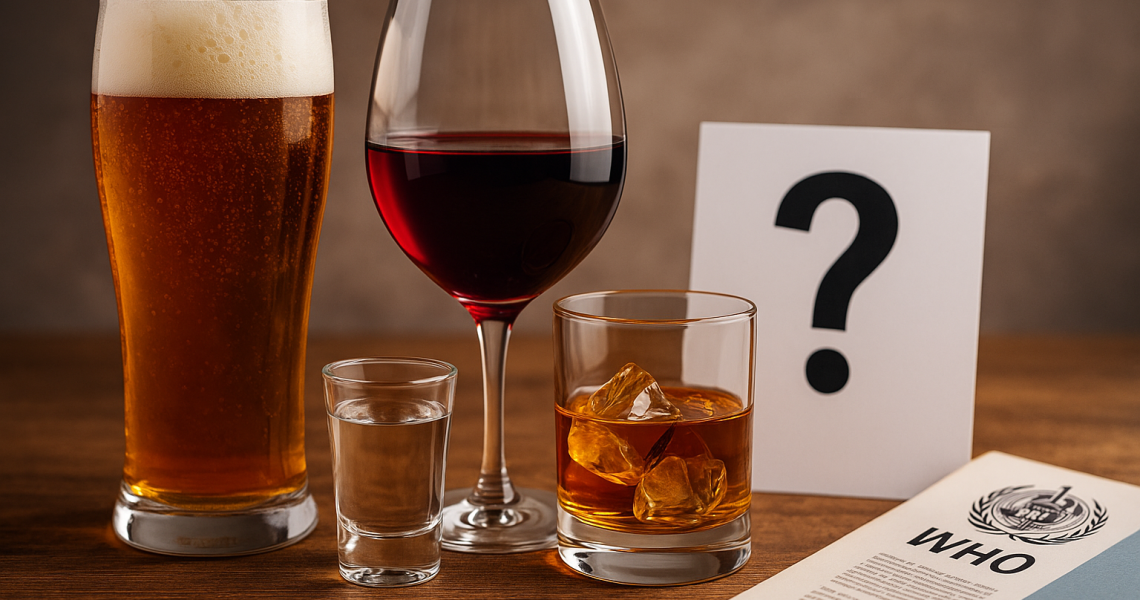Can we still talk about “good wine” or moderate consumption when science is sounding the alarm?
More and morestudies are showing that no type ofalcohol is really harmless, regardless of the glass or the quantity. Behind the convivial image of an aperitif lies a darker reality: an increased risk of disease, particularly cancer, and deleterious effects on mental and cardiovascular health.
So, are some alcohols really “less” harmful than others? The answer, according to research, is far more complex than it seems.

The myth of “protective” red wine
For years, advertising has extolled the benefits of red wine, thanks in particular to polyphenols, the antioxidant compounds found in grape skins. It was long thought that one or two glasses a week could protect the heart and liver, reducing cardiovascular risk.
But recent studies, such as those published in The Lancet, contradict this belief. Professor David Nutt, an addiction specialist, points out that while certain compounds in wine may have an isolated beneficial effect, they never compensate for the toxic effects of ethanol. In other words, polyphenols do not “neutralize” the risk.
Modern research therefore nuances this romantic idea of “heart-friendly” wine. According to theWHO, no amount ofalcohol is safe. The famous “glass of red wine a day” is no longer a health guide, but a cultural relic difficult to erase.
Beer, wine or spirits: all in the same boat
Whether it’s beer, wine or spirits, the effects on health are broadly comparable. Perceived differences have more to do with the mode of consumption than the type of beverage.
Beer drinkers, for example, tend to consume larger quantities because of the lower alcohol content per glass. Lovers of spirits, on the other hand, absorb a more concentrated dose, causing a more rapid effect on the liver and mental health.
And those who think that wine remains “less” harmful are mistaken: according to a European study, the incidence of certain cancers (notably breast and liver) is as high among wine lovers as among other regular drinkers.
Differences in risk are therefore marginal. It’s not the type of alcohol that counts, but the quantity, frequency and duration of exposure.
A question of dose… and frequency
TheWHO recommends drastically limiting alcohol consumption. For a healthy adult, this means a maximum of 1-2 drinks a week, with days of total abstinence.
The body does not metabolize alcohol in a linear fashion: a so-called “moderate” drink can have cumulative effectsover time. The liver, the main detoxification organ, suffers the direct impact of these repeated quantities, leading to inflammation, fibrosis and even cirrhosis.
Women are even more vulnerable. Because of their lower body mass and water content, their bodies concentrate more ethanol. The same amount of alcohol will therefore have a more marked effect than in men, increasing the risk of breast or liver cancer.
Studies are unanimous: even low consumption can lead to chronic illness. And contrary to what some bars and advertising campaigns suggest, no type of alcohol offers any real “protection”.
The role of prevention and research
Prevention rests on three pillars: information, regulation and support. Advertisingmessages promoting the supposed benefits of wine need to be controlled, as they mask the reality of health issues.
Epidemiological studies, financed by independent public agencies, underline that the perception of “lower” or “more natural” alcohol is nothing but a marketing mirage.
Professor Kevin Shield, from the University of Toronto, points out in a study published in The Lancet that the so-called “protective”effect only exists in populations with very low consumption, and even then, it never offsets the overall risk.
Prevention efforts must also include mental health: addiction, anxiety, sleep disorders and reduced concentration are among the most neglected effects.
What if we changed our relationship with alcohol?
Today, more and more research is calling for a rethinking of our cultural relationship with drink. Wine, beer and spirits are not isolated enemies, but symbols of a complex social relationship to relaxation, celebration and emotion.
Alternatives exist: alcohol-free drinks, fruit-based cocktails, or simply conscious moderation. Dieticians and prevention specialists also recommend diversifying pleasures: sport, nature, rest, meditation… anything that frees the brain from the need for a “comfort drink”.
As global research underlines, the key is not to prohibit, but to inform, support and propose healthy choices. The guide to modern health is based on a simple idea: a body free of dependence lives longer, better and freer.
In a nutshell
- No type of alcohol is really “less” dangerous.
- The supposed positive effects of red wine are outweighed by its carcinogenic risks.
- Prevention, moderation and transparency remain the only real weapons in the fight against consumption-related diseases.
What if true luxury no longer lay in a glass of wine, but in preserved health?
